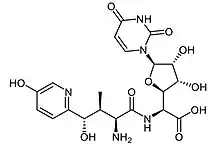
Nikkomycins are a group of antifungal medications.[1] They work by interfering with the building of the fungal cell wall which results in the fungal cell breaking open.[1] They were discovered in 1976.[1] The specific agent nikkomycin Z has weak activity against Aspergillus fumigatus which may be of benefit when used with other medications,[1] such as caspofungin, ranconazole and amphotericin B, fluconazole or itraconazole.[2] Nikkomycin Z also inhibits growth of Batrachochytrium dendrobatidis, a serious fungal pathogen linked to global amphibian declines, while lower concentrations of Nikkomycin Z enhanced natural amphibian antimicrobial skin peptide effectiveness in vitro.[3]
Originally identified from Streptomyces tendae, the nikkomycins are chitin synthase inhibitors.[2]
References
- 1 2 3 4 Steinbach, WJ; Stevens, DA (1 October 2003). "Review of newer antifungal and immunomodulatory strategies for invasive aspergillosis". Clinical Infectious Diseases. 37 (Suppl 3): S157-87. doi:10.1086/376523. PMID 12975751.
- ↑ Holden, Whitney M; Fites, J Scott; Reinert, Laura K; Rollins-Smith, Louise A (January 2014). "Nikkomycin Z is an effective inhibitor of the chytrid fungus linked to global amphibian declines". Fungal Biology. 118 (1): 48–60. doi:10.1016/j.funbio.2013.11.001. PMID 24433676. Retrieved 17 June 2021.